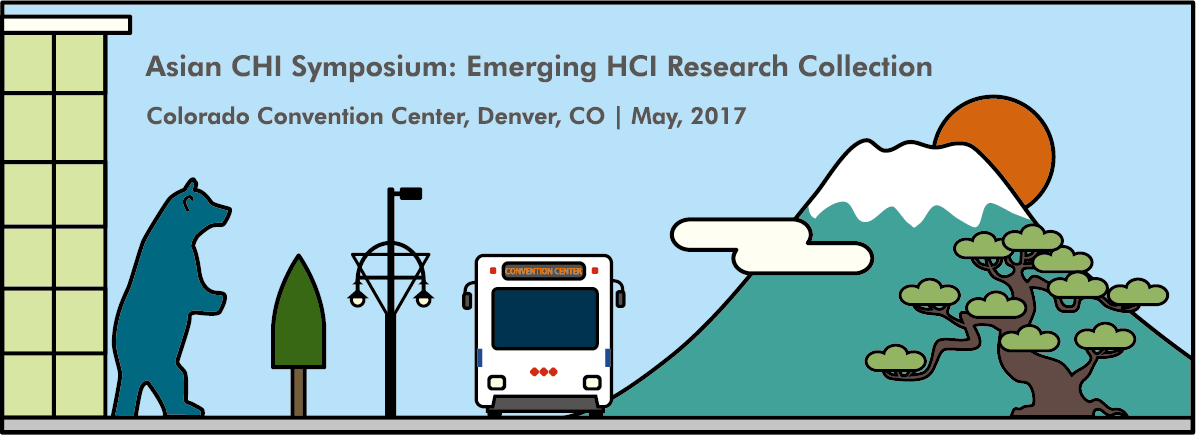For those fluent in Japanese: there is a Japanese version of this CfP (日本語参考訳).
This symposium would like to invite position and research papers about latest HCI research. This workshop aims to collect work originated from Japan or closely related to the Japanese culture and society, and promote its unique problems and approaches to a wider community. This workshop is also intended to promote social exchange among young researchers, more specifically, researchers who recently received their doctorates and Ph.D. candidates who are 1 – 2 years away from graduation.
Themes
We invite any type of HCI research that is originated from Japan or closely related to the Japanese culture and society, such as:
- Novel interactive systems and interaction techniques;
- Novel hardware and software enabling new forms of interaction with computers;
- Studies for understanding human capabilities related to interaction with computers;
- Theories that explain human behaviors around computer systems;
- Systems and services that address issues prominent in Japan (e.g., population, aging, and diversity in working environments); and
- Input and output systems to support creative activities and expressions.
The work must be original though it does not have to be complete; work with preliminary results is welcome. Work already published in an archival form at another journal or conference may be considered as a valid submission. A submission of such work should clearly state the existence of related prior publications. We also welcome work that can be considered controversial or unconventional unless it could pose strong ethical concerns.
This symposium also aims to broaden participation of young researchers in Japan (e.g., recently-graduated Ph.D.s, graduate students, and even undergraduates who have strong interests in HCI). Preferences will be given to such participants though we welcome submissions from anyone.
Deadlines
Submission Deadline: Feb 24, 2017. (EXTENDED)
Notification: Mar 3, 2017 (Review will be sent at Mar 10, 2017)
Submission
We invite both paper submissions (in the ACM Extended Abstract Format) and submissions of websites or systems that describe the research. All submissions should include:
- A section of “Future Impact,” describing potential impact of this work and research direction in a long term (e.g., 10 years),
- References to publicly-accessible resources on prior work (either in academic or commercial context), and
- A short bio of author(s).
Paper submission
Papers should be formatted as ACM Extended Abstract. Each paper should be 2 — 6 pages (excluding references), and should adhere to the extended abstract guidelines given in the template.
More experimental submission (ex. website, video and system)
While we do not limit the file size nor the file format, the website or system submissions should be playable on common computers such as Windows or Mac OS X. More importantly, they must contain academic content comparable to the ordinary paper submissions such as introductions, citations to related work and precise descriptions of the proposed methods.
Supplementary Material
We also strongly encourage the authors to submit accompanying videos. The videos can illustrate a future form of interactive technologies (more like a vision video) or demonstrating research prototypes and art exhibitions created by the authors. A vision video does not need to show a demonstration of any working prototype, but must illustrate a clear, stimulating vision of how interactive technologies could flourish people’s life in the future.
CHI Symposium Challenge
Upon the submission, authors can choose to submit as “CHI Symposium Challenge”, which includes the deployment of the proposed system at the symposium. When a CHI Symposium Challenge submission is accepted, the organizers will do their best to accommodate the system deployment at the symposium venue.
Paper Selection
Each submission will be reviewed under the following criteria:
- Originality;
- Significance; and
- Validity.
Since the symposium aims to broaden participation of young researchers, preferences will be given to such participants though we welcome submissions from anyone.
All authors with accepted submissions are expected to give poster presentations OR demonstrations at the symposium. Demonstrations do not have to be fully developed and can be informal and ad-hoc; even playing demo videos with mobile/tablet devices would suffice. Due to the constraints of the venue, we are not able to accommodate demonstrations that require large space or external special equipment. Demonstrations that will not produce large noise or anything that could potentially affect other workshops running in parallel will not be accepted. Our intention to have demonstrations is to encourage active discussions with other participants.
Conference Registration
At least one author of each accepted position paper must attend the workshop and that all participants must register for both the workshop and for at least one day of the conference. For more details about registration, please refer to CHI2017 website.
